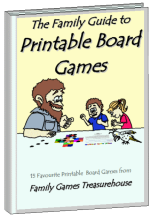Up the Creek Without a Paddle
Up the Creek Without a Paddle was invented around thirty years ago when some friends grew tired of playing Euchre and Five Hundred, and decided to develop a new game which was both challenging and yet simple to play. The name Up the Creek Without a Paddle was used for no particular purpose, except that we had been canoeing that day! (See Glossary if you are confused about any card game terms. The Glossary will open in a new window.)
Age: Older children and adults
No. of players: 3-8
Equipment: One standard deck of cards (remove the jokers)
Time: 30 minutes+
Aim: To get the highest score by correctly guessing the number of tricks you will win each round. A full game of Up the Creek Without a Paddle can be from 6 to 19 rounds.
1. The deck is shuffled. Players cut the cards - the highest card (Aces High) becomes dealer for the first round.
2. Cards are dealt clockwise, one at a time, face down to each player.
- 3-4 players = 10 cards each
5-6 players = 8 cards each
7-8 players = 6 cards each
3. Each player (starting with Player One on the dealer's left) tries to guess how many tricks they will win, based on the cards in their hand. There are no trumps or bowers in Up the Creek. This gives Player One an advantage since they play the first card and other players must follow suit. (Be aware that there will always be cards in the pile on the side of the table, so it is possible that the highest card in a suit could be the Queen or Jack. Conversely, you could win a trick with a four or five if other players have only off-suit cards to play.) Each player can guess from zero to the maximum number of cards in their hand. However, the dealer CANNOT estimate a number which would let every player win. For example, four players with ten cards each may have the following bids.
- Player One - four tricks
Player Two - three tricks
Player Three - zero tricks
Player Four (the dealer) cannot bid for three tricks, since then 4+3+0+3=10 and everyone could win. Instead the dealer could bid 0, 1, 2, 4, 5, or up to 10 if they were really confident!)
4. Player One leads their first card to start the first trick. Other players complete the trick by following suit if possible. (If a player reneges, they lose 20 points.) The player with the highest card (Aces High) of the suit which was led wins the trick. Whoever wins the trick picks up the cards and puts them in a pile face down in front of them. The winner then leads the next card, and so on for each trick until all the cards have been played for that round.
5. Scoring then takes place. Every player starts on 100 points. If they win the number of tricks they bid for, they get ten points plus the number of tricks they won. For example, if they bid for and won six tricks, they would gain 16 points. Players who do not win the number of tricks they bid for will lose the difference between their bid and the number of tricks won. For example, if they bid for six tricks but only won four, they would lose two points (6-4=2). If they bid for six tricks but won seven, they would lose one point. However, if a player wins all the tricks, they gain an extra five points, in addition to any other points gained or lost. Any player who reneged during the round loses 20 points.
6. Round Two starts with Player One becoming the new dealer. This time, each player receives one less card, and so on for subsequent rounds. Thus, the number of rounds equals the initial number of cards received (that is, 3-4 players = 10 rounds, 5-6 players = 8 rounds, 7-8 players = 6 rounds). In the final round (with only one card) the player to the dealer's left has an obvious advantage since they lead and others must follow suit. If a player bids and wins the one trick, they will get 16 points (Ten points for getting their bid, one point for getting one trick and five points for winning all the tricks (one!)). This can change the final scores (and winner) very quickly.
7. The overall winner of Up the Creek Without a Paddle is the player with the highest score at the end of all the rounds.
Variation: The original version of Up the Creek Without a Paddle had almost twice the number of rounds. After players worked down from the maximum number of cards to one card per round, they then started building the number of cards back up to the maximum again. For 3-4 players, there would be 19 rounds (ten rounds from ten cards to one card, and nine more from two cards back up to ten cards). This made the game much longer but allowed better players to win by skill rather than just a lucky card in the final round.
| Click on the links below for more Card Games such as ... | |
| More card games for two players |
Card games for children of all ages |
| Crazy Eights Go Fish Hockey Card Game Rummy |
Snap Old Maid My Ship Sails Clock Patience (for one player) |
|
Do you have a favourite Card game that you want to share with all our readers? You can share YOUR Card game and/or check out other readers' favourite Card games. It's easy! Just click on this share YOUR Card game link and follow the instructions. | |
Thank you for visiting our website!
Parlor Games | Board Games | Traveling Games | Tile (Domino) Games
Card Games | Worldwide Games | Outdoor Games | Dice Games | Word Games
Christmas Games | Easter Games | Thanksgiving Games
Family Reunion Games | Valentines Games





